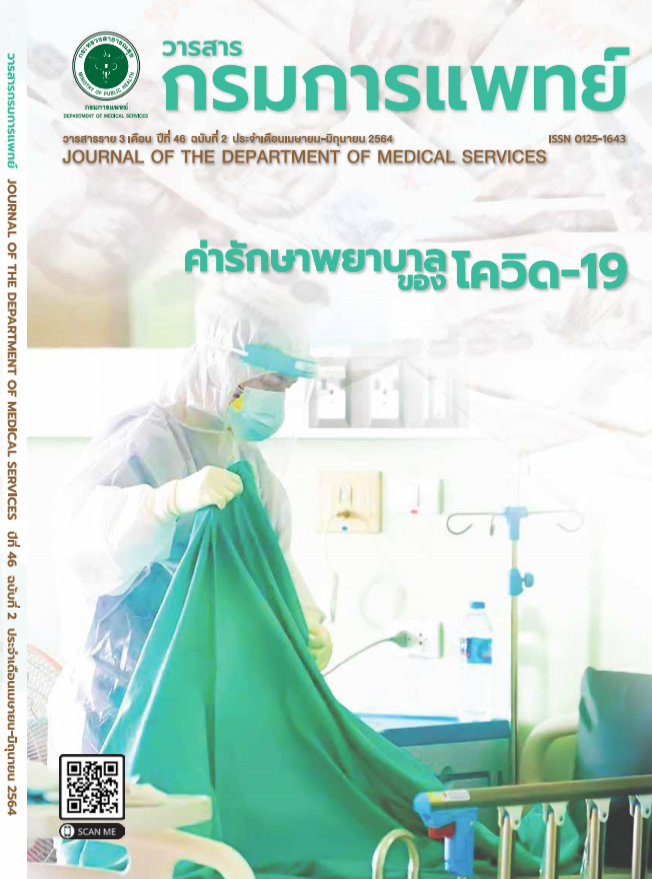การเปรียบเทียบความแข็งผิวระดับจุลภาควิกเกอร์สในวัสดุ อุดฟัน เซอร์โคโนเมอร์ อิมพรูฟ ไจโอเมอร์และเรซินคอมโพสิต
คำสำคัญ:
เซอร์โคโนเมอร์, เซอร์โคโนเมอร์ อิมพรูฟ, กลาสไอโอโนเมอร์ซีเมนต์บทคัดย่อ
ภูมิหลัง: เซอร์โคโนเมอร์ อิมพรูฟ เป็นกลาสไอโอโนเมอร์ ซีเมนต์ที่มีการพัฒนาสูตรโดยเสริมแรงด้วยอนุภาคนาโนของ เซอร์โคเนีย ทำให้มีความแข็งแรง คงทน ปลดปล่อยฟลูออไรด์ และมี ความโปร่งแสง ทำให้มีสีคล้ายกับฟันธรรมชาติ อาจจะเป็นทางเลือก หนึ่งในการบูรณะฟันหลังในบริเวณที่ต้องการความสวยงามและช่วย ต้านทานการเกิดฟันผุได้วัตถุประสงค์: เพื่อศึกษาความแข็งผิวระดับ จุลภาควิกเกอร์ของวัสดุเซอร์โคโนเมอร์ อิมพรูฟ เปรียบเทียบกับ ไจโอเมอร์และเรซินคอมโพสิตวิธีการ: เตรียมชิ้นทดสอบ 45 ชิ้น จากวัสดุบูรณะ 3 ชนิด วัดความแข็งผิวระดับจุลภาควิกเกอร์ส ที่ ช่วงเวลา 1 ชั่วโมง 24 ชั่วโมง และ 7 วัน วิเคราะห์ข้อมูลด้วยสถิติ การทดสอบความแปรปรวนทางเดียวที่ระดับนัยสำคัญ (p<0.05)ผล: เมื่อเปรียบเทียบระหว่างวัสดุทั้ง 3 ชนิดในแต่ละช่วงเวลามีค่า ความแข็งผิวแตกต่างกันอย่างมีนัยสำคัญทางสถิติ (p <0.05) ช่วง เวลาที่ต่างกันของเรซิน คอมโพสิตและไจโอเมอร์ มีค่าความแข็งผิว ไม่แตกต่างกัน ส่วนค่าความแข็งผิวของเซอร์โคโนเมอร์ อิมพรูฟ ต่าง กันอย่างมีนัยสำคัญทางสถิติ (p <0.05) ที่ระยะเวลา 1 ชั่วโมง 24 ชั่วโมง และที่ 7 วันมีค่าความแข็งผิวสูงสุดอยู่ที่ 76.82 kg/mm2สรุป : เซอร์โคโนเมอร์ อิมพรูฟ มีค่าความแข็งผิวสูงกว่าเรซินคอมโพสิต เมื่อวัดที่ระยะเวลา 7 วัน โดยเซอร์โคโนเมอร์ อิมพรูฟที่ 1 ชั่วโมง มี ค่าความแข็งผิวน้อยที่สุดแต่มีค่าเพิ่มขึ้นเมื่อเวลาผ่านไป
References
Dallı M, Çolak H, Mustafa Hamidi M. Minimal intervention concept: a new paradigm for operative dentistry. J Investig Clin Dent 2012;3:167-75.
Kopperud SE, Tveit AB, Gaarden T, Sandvik L, Espelid I. Longevity of posterior dental restorations and reasons for failure. Eur J Oral Sci 2012;120:539-48.
Sharafeddin F, Shoale S, Kowkabi M. Effects of different percentages of microhydroxyapatite on microhardness of resin-modified glass-ionomer and zirconomer. J Clin Exp Dent 2017;9:e805-e811.
Gordan VV, Blaser PK, Watson RE, Mjör IA, McEdward DL, Sensi LG, et al. A clinical evaluation of a giomer restorative system containing surface prereacted glass ionomer filler: results from a 13-year recall examination. J Am Dent Assoc 2014;145:1036-43.
Albeshti R, Shahid S. Evaluation of Microleakage in Zirconomer®:A Zirconia Reinforced Glass Ionomer Cement.Acta Stomatol Croat 2018;52:97-104.
Zanata RL, Magalhaes AC, Lauris JR, Atta MT, Wang L,Navarro MF. Microhardness and chemical analysis of high-viscous glass-ionomer cement after 10 years of clinical service as ART restorations. J Dent 2011;39:834-40.
Wang L, D’Alpino PHP, Lopes LG, Pereira JC. Mechanical properties of dental restorative materials: relative contribution of laboratory tests. J Appl Oral Sci 2003;11:162-7.
Moshaverinia A, Brantley WA, Chee WW, Rohpour N, Ansari S, Zheng F, et al. Measure of microhardness, fracture toughness and flexural strength of N-vinylcaprolactam (NVC)-containing glass-ionomer dental cements.Dent Mater 2010;26:1137-43.
Dionysopoulos D, Tolidis K, Gerasimou P, Sfeikos T. Effect of Three Clinical Curing Treatments on Fluoride Release and Surface Hardness of Glass-Ionomer Cements. Int J Periodontics Restorative Dent 2017;37: e197-e203.
Pontes LF, Alves EB, Alves BP, Ballester RY, Dias C, Silva CM. Mechanical properties of nanofilled and microhybrid composites cured by different light polymerization modes. Gen Dent 2013;61:30-3.
Kaminedi RR, Penumatsa NV, Priya T, Baroudi K. The influence of finishing/polishing time and cooling system on surface roughness and microhardness of two different types of composite resin restorations. J Inter Soc Prev Community Dent 2014;4:S99-104.
Tanthanuch S, Kukiattrakoon B, Siriporananon C, Ornprasert N, Mettasitthikorn W, Likhitpreeda S, et al. The effect of different beverages on surface hardness of nanohybrid resin composite and giomer. J Conserv Dent 2014;17:261-5.
Garoushi S, Vallittu PK, Lassila L. Characterization of fluoride releasing restorative dental materials. Dent Mater J 2018;37:293-300.
Strnad G, Kovacs M, Andras E, Beresescu L. Effect of curing, finishing and polishing techniques on microhardness of composite restorative materials. Procedia Technology 2015;19:233-8.
Bala O, Arisu HD, Yikilgan I, Arslan S, Gullu A. Evaluation of surface roughness and hardness of different glass ionomer cements. Eur J Dent 2012;6:79-86.
Irie M, Suzuki K, Watts DC. Delayed polishing technique on glass–ionomer restorations. Japanese Dental Science Review 2009;45:14-22.
Madhyastha PS, Hegde S, Srikant N, Kotian R, Iyer SS. Effect of finishing/polishing techniques and time on surface roughness of esthetic restorative materials. Dent Res J 2017;14:326-30.
Lien W, Vandewalle KS. Physical properties of a new silorane-based restorative system. Dent Mater 2010;26:337-44.
Kooi T, Tan Q, Yap AU, Guo W, Tay KJ, Soh MS. Effects of foodsimulating liquids on surface properties of giomer restoratives.Oper Dent 2012;37:665-71.
Alzraikat H, Burrow MF, Maghaireh GA, Taha NA. Nanofilled resin composite properties and clinical performance: a review. Oper Dent 2018;43:E173-E190.
Schulze KA, Marshall SJ, Gansky SA, Marshall GW. Color stability and hardness in dental composites after accelerated aging. Dent Mater 2003;19:612-9.
Moberg M, Brewster J, Nicholson J, Roberts H. Physical property investigation of contemporary glass ionomer and resin-modified glass ionomer restorative materials. Clin Oral Investig 2019;23:1295-308.
Ellakuria J, Triana R, Mınguez N, Soler I, Ibaseta G, Maza J, et al. Effect of one-year water storage on the surface microhardness of resin-modified versus conventional glass-ionomer cements.Dent Mater 2003;19:286-90.
Asafarlal S. Comparative Evaluation of Microleakage, Surface Roughness and Hardness of Three Glass Ionomer Cements–Zirconomer, Fujii IX Extra GC and Ketac Molar: An. Vitro; 2017.
Downloads
เผยแพร่แล้ว
How to Cite
ฉบับ
บท
License

This work is licensed under a Creative Commons Attribution-NonCommercial-NoDerivatives 4.0 International License.
บทความที่ได้รับการตีพิมพ์เป็นลิขสิทธิ์ของกรมการแพทย์ กระทรวงสาธารณสุข
ข้อความและข้อคิดเห็นต่างๆ เป็นของผู้เขียนบทความ ไม่ใช่ความเห็นของกองบรรณาธิการหรือของวารสารกรมการแพทย์


